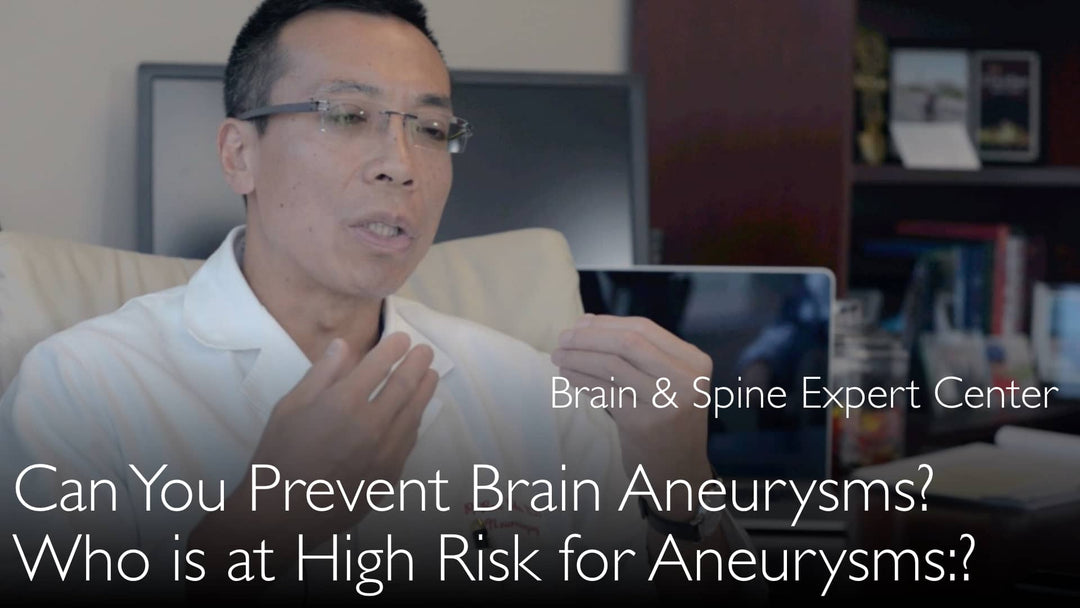Leading expert in cerebrovascular and endovascular neurosurgery, Dr. Peng Chen, MD, explains how to decrease the risk of brain aneurysm formation and rupture by controlling key modifiable risk factors like smoking and hypertension, while also detailing the importance of family history and genetic predisposition in determining individual risk profiles.
Brain Aneurysm Prevention: How to Reduce Your Risk of Rupture
Jump To Section
- Understanding Brain Aneurysm Risk
- Key Modifiable Risk Factors
- The Role of Family History
- Hereditary Brain Aneurysm Patterns
- Screening for High-Risk Individuals
- Lifestyle Changes for Prevention
- When to Seek Medical Advice
Understanding Brain Aneurysm Risk
Brain aneurysms are surprisingly common, affecting an estimated 0.9% to 9% of the general population. As Dr. Peng Chen, MD, explains, this data comes from historical autopsy studies, indicating that many people live their entire lives with a small, unruptured intracranial aneurysm without ever knowing it. The critical clinical concern is not the mere presence of an aneurysm but its potential to rupture. A ruptured brain aneurysm causes a hemorrhagic stroke and carries a devastatingly high mortality rate, which can be up to 50%.
Key Modifiable Risk Factors
Preventing a brain aneurysm from forming or rupturing centers on addressing well-established, modifiable risk factors. According to Dr. Peng Chen, MD, the two most significant factors are cigarette smoking and uncontrolled high blood pressure (hypertension). Smoking directly damages and weakens blood vessel walls, while persistent hypertension places excessive pressure on these vulnerable areas, increasing the likelihood of an aneurysm developing or a existing one bursting. Conditions that promote atherosclerotic disease, such as high cholesterol and triglyceride levels, also negatively impact cerebrovascular health and contribute to overall risk.
The Role of Family History
Genetic predisposition plays a crucial role in brain aneurysm risk. Dr. Peng Chen, MD, notes that brain aneurysms can occur in about 10% of relatives of a patient with a diagnosed aneurysm. This familial tendency often follows a direct line, such as from a grandmother to a mother to a daughter. A family history of strokes or unexplained cerebrovascular events can be a significant red flag signaling an inherited risk for aneurysm formation, making it an essential topic to discuss with a physician.
Hereditary Brain Aneurysm Patterns
In cases of familial or hereditary brain aneurysms, a fascinating and critical pattern emerges. Dr. Chen points out that these aneurysms often have a tendency to rupture at a similar age across different generations within the same family. While the exact genetic and biological mechanisms behind this pattern are not fully understood, this clinical observation is vital. It underscores the importance of proactive screening for individuals with a strong family history, as it allows for potential intervention before a rupture occurs at a predictable life stage.
Screening for High-Risk Individuals
For patients with a family history of intracranial aneurysms, Dr. Peng Chen, MD, recommends early non-invasive imaging. A magnetic resonance angiography (MRA) is a common screening tool that can detect the presence of an aneurysm without the need for more invasive procedures. This proactive approach to screening is a cornerstone of prevention for high-risk individuals, enabling neurosurgeons to monitor stable aneurysms or plan elective treatment for those deemed at high risk of rupture, thereby avoiding a catastrophic emergency.
Lifestyle Changes for Prevention
The most effective steps for brain aneurysm prevention involve lifestyle modifications. Dr. Peng Chen, MD, emphasizes that eliminating cigarette smoking is the single most impactful change one can make. Controlling blood pressure through diet, exercise, and medication if necessary is equally critical. Maintaining general health through regular exercise and managing cholesterol levels supports overall vascular integrity. As Dr. Peng Chen, MD, explains, anything that compromises the health of coronary arteries will also negatively affect the blood vessels in the brain.
When to Seek Medical Advice
Individuals with multiple risk factors should consult a healthcare professional for a personalized risk assessment. This is especially important for those with a direct family history of brain aneurysms or hemorrhagic stroke. During the interview with Dr. Anton Titov, MD, Dr. Chen highlighted that a medical second opinion can be invaluable for those already diagnosed with an aneurysm. It confirms the diagnosis and ensures the chosen treatment plan—whether monitoring, endovascular coiling, or surgical clipping—is the most appropriate option for the specific case.
Full Transcript
Dr. Anton Titov, MD: How to prevent brain aneurysms? How to decrease risk of cerebral aneurysm rupture? Can you prevent a brain aneurysm? What can you do to prevent an aneurysm? What causes brain aneurysm to form?
Leading endovascular and cerebrovascular neurosurgeon shares his view on risks and prevention of brain aneurysms. Family history of strokes or unexplained cerebrovascular events can signal a risk factor for brain aneurysm formation.
Prevent brain aneurysms. Decrease risk of cerebral aneurysm rupture. Video interview with top expert in endovascular neurosurgery. Medical second opinion confirms that brain aneurysm diagnosis is correct and complete.
Medical second opinion helps to choose the best treatment for brain aneurysm. Get medical second opinion on cerebral aneurysm and be confident that your treatment is the best.
Risk factors for brain aneurysms are smoking, poorly controlled blood pressure, hypertension, atherosclerosis of blood vessels. Not all brain aneurysms rupture. But brain aneurysms tend to rupture at the same age in different generations of one family.
Reduce risk of intracranial aneurysms. How to prevent brain aneurysms and decrease risk. How to prevent brain aneurysms? When the risk for brain aneurysm increases?
Dr. Peng Chen, MD: This is still one of the questions in the research phase. We gain more knowledge as time goes by. However, we do know a few risk factors for brain aneurysms. There are some common risk factors. People can learn to reduce risk of developing intracranial aneurysms.
In the general population, probably 0.9% to 9% of people might have a small intracranial aneurysm. These facts are based on 1950s to 1980s autopsy data. So this is not perfect, but you can say this is definitely population-based, and it's meaningful.
The truth is that only a certain small number of these patients will have a ruptured brain aneurysm during their lifetime. So there is a fair amount of patients that never rupture a brain aneurysm.
On the other hand, if a brain aneurysm ruptures, death rate could be up to 50%. That's exactly correct. It is important to think that we know there are risk factors for brain aneurysm development. They are less debatable.
It is cigarette smoking, uncontrolled high blood pressure. It is persistently high blood pressure. There are also factors that promote atherosclerotic disease. For example, there are genetic factors. They are hard to determine.
Genetic risks for brain aneurysm are hard to change. Control your cholesterol level. Control your triglyceride level. It puts additional meaning on these risks.
Anything that can potentially compromise your coronary artery vessels, your body vessels, will also reflect negatively on brain vessels. Therefore, as I emphasized before, cigarette smoking should be the one thing we can eliminate.
Stop smoking easily. Alter our lifestyle. Completely eliminate smoking. Blood pressure you can control to decrease brain aneurysm risk. Sometimes you have a blood pressure problem.
Obviously with certain medications you can get a good control. General health. Exercise is always meaningful. They are things that perhaps are much more difficult to alter.
There could be a family history of intracranial aneurysms. Brain aneurysms can happen in about 10 percent of relatives of a patient with brain aneurysms. Typically, cerebral aneurysms happen along the same direct family line.
For example, mother has aneurysm and grandmother had brain aneurysm. Mother had a cerebral aneurysm rupture. So daughter might need to look into potential risk of intracranial aneurysms present.
Brain aneurysm will have a potential risk of rupture. We also have a thought about some of the familial brain aneurysms. We call them hereditary brain aneurysms. It could be due to multifactorial genetic involvement.
From the clinical standpoint, these brain aneurysm patients have a tendency to rupture brain aneurysms at a similar age. We don't know why it happens. But we do know that brain aneurysm bleeding is going to happen at a similar age.
So this fact needs to be kept in mind. These patients have family histories with brain aneurysms. Then we recommend these patients early on to have non-invasive imaging study done (MRI angiography).
How to prevent brain aneurysms and decrease risk. Can you prevent a brain aneurysm? Can I prevent rupture of cerebral aneurysm? Smoking, hypertension, stroke prevention.





